BY J. DOUGLAS HINTON
With the meltdown of the Soviet Union in 1991, Ukraine gained its independence, causing private enterprise to bloom, including Kiev-based Aeroprakt company, founded the same year and bolstered by an investment by Saudi Sheik Hussein. The result was several Light-Sport Aircraft, principally the Aeroprakt A22-LS.
Designed by Yuri Yakovlev, the LSA has become so popular around the world that it is currently the only model on Aeroprakt’s production line.
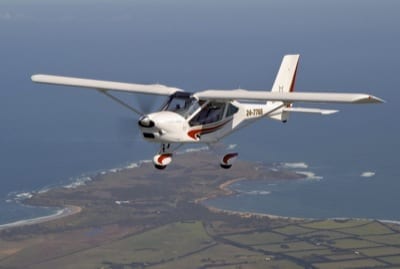 With more than 100 LSA models now available in the United States — with most manufactured outside the country — the A22-LS is no newcomer. A proven product since its inception, approximately 500 have been sold, including 30 in the United States.
With more than 100 LSA models now available in the United States — with most manufactured outside the country — the A22-LS is no newcomer. A proven product since its inception, approximately 500 have been sold, including 30 in the United States.
The LSA is distributed in the U.S. by Aeroprakt America, based in DeLand, Florida (just north of Orlando). The company is technically not a dealer, according to company president Douglas Karlsen (pictured below).
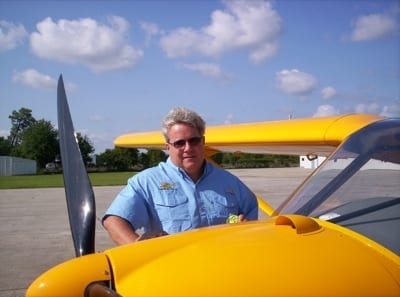 “Actually we’re part of the factory,” he explained. “We get our product shipped in a box from Ukraine. We then assemble the aircraft in DeLand, install the avionics, test fly it with an inspector to qualify for the airworthiness certificate, and we’re good to go. Lead time from order to certificate is approximately three months.”
“Actually we’re part of the factory,” he explained. “We get our product shipped in a box from Ukraine. We then assemble the aircraft in DeLand, install the avionics, test fly it with an inspector to qualify for the airworthiness certificate, and we’re good to go. Lead time from order to certificate is approximately three months.”
Briefly stated, the A22LS is a high-wing, single engine, two side-by-side seater model with tricycle fixed landing gear or optional amphibious floats. The LSA is all metal, except for the composite nose cowl and fabric control surfaces. Maximum takeoff weight is 1,320 pounds or 1,430 pounds for the amphibian. It has nose wheel steering via the rudder pedals and cantilever spring type landing gear with disc brakes. An optional parachute system for the plane can be had, although Karlsen confesses he hasn’t sold any as yet.
Two engines are available: The 80-hp Rotax 912UL and the 100-hp 912ULS. Karlsen reports all the aircraft he has sold favored the beefier engine. Both carry a TBO of 2,000 hours.
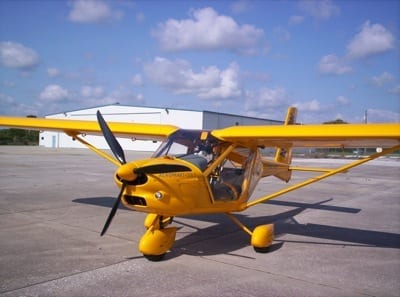 Perhaps the LSA’s most striking feature is the visibility available — front, sides, down and rear, almost like a helicopter, making it ideal for traffic watch, rescue operations, aerial photography, and surveillance. The 23.5 gallons of wing fuel (mogas or 100LL) offer an endurance of nine hours long range or loiter time.
Perhaps the LSA’s most striking feature is the visibility available — front, sides, down and rear, almost like a helicopter, making it ideal for traffic watch, rescue operations, aerial photography, and surveillance. The 23.5 gallons of wing fuel (mogas or 100LL) offer an endurance of nine hours long range or loiter time.
Another interesting feature is the flaperons or “drooping ailerons,” which can act as either ailerons or three position flaps.
I met Karlsen at Kissimmee’s Gateway Airport (ISM) near Orlando for the demo flight. The day was bright and sunny, but with gusty winds. Fortunately they did not exceed the aircraft’s maximum crosswind component of 14 kts.
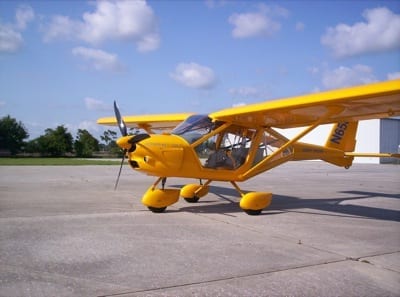 The walkaround inspection was fairly standard. The cowling was easily removed to check the oil and the fuel drained from the three sumps (under each wing and the fuselage). The flaperons came next for any signs of damage. We were good to go.
The walkaround inspection was fairly standard. The cowling was easily removed to check the oil and the fuel drained from the three sumps (under each wing and the fuselage). The flaperons came next for any signs of damage. We were good to go.
Seated in the cockpit, the first thing noted was the width of the cabin. Even big guys will find their shoulders and arms don’t touch. Located behind the seats is a baggage compartment consisting of a closeable bag with 44 pounds capacity.
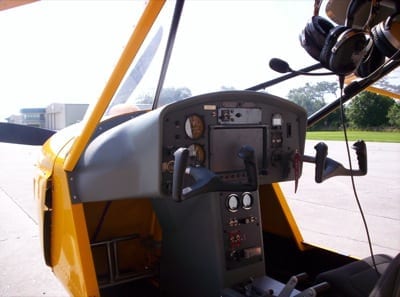 Most notable on the panel was the Dynon FlightDEK-D180 display, which gives the pilot traffic and terrain displays, GPS info, true airspeed and groundspeed, altimeter, rate of climb, and other features. The glass panel also has several steam gauges as backup. With dual rudder pedals and yokes, the aircraft can be flown from either seat. Brakes are incrementally applied by means of a handle centrally located beside the throttle and are very effective. Rotatable air scoops are installed on either door and can be closed when heat is required.
Most notable on the panel was the Dynon FlightDEK-D180 display, which gives the pilot traffic and terrain displays, GPS info, true airspeed and groundspeed, altimeter, rate of climb, and other features. The glass panel also has several steam gauges as backup. With dual rudder pedals and yokes, the aircraft can be flown from either seat. Brakes are incrementally applied by means of a handle centrally located beside the throttle and are very effective. Rotatable air scoops are installed on either door and can be closed when heat is required.
With the parking brake set, it was time for engine start. The Rotax responded immediately and we were ready to taxi using the rudder pedals to direct the nosewheel steering. Following a magneto and controls check, we lowered approach flaps and were ready for takeoff. I asked Karlsen to demonstrate a short field takeoff followed by maximum rate of climb. Holding the brakes he ran the engine up to full power, then let go. We were off before the runway numbers ( a little over 300 feet) and…WHOA!!… climbing like the proverbial homesick angel at about 800 fpm and 54 kts IAS, arriving at 1,000 feet halfway down the runway.
As Karlsen reassured himself my heart was still beating, we headed west for some airwork, climbing to 2,500 feet to lessen the choppy air.
While the A22-LS won’t set your hair on fire, there’s no need for that, considering the roles previously mentioned, plus training. Cruise speed is 97 kts@5,400 rpm.
 After cruising around doing some turns, we did a couple of stalls, clean and dirty at 45 and 36 kts respectively. Nothing scary here, just a slight buffet with the nose dropping straight ahead. Recovery was simply a matter of releasing the back pressure and we were flying again. Intentional spins are prohibited but the aircraft showed no tendencies to enter one.
After cruising around doing some turns, we did a couple of stalls, clean and dirty at 45 and 36 kts respectively. Nothing scary here, just a slight buffet with the nose dropping straight ahead. Recovery was simply a matter of releasing the back pressure and we were flying again. Intentional spins are prohibited but the aircraft showed no tendencies to enter one.
I then pushed the nose down without trimming until we reached Vne at 120 kts, at which point I released the yoke to check stability. The nose rose without a wing drop and within a couple of vertical oscillations we were level again. By the way, the ceiling on the ULS model is a little over 16,000 feet.
Returning to Kissimmee, Karlsen demonstrated a short field landing with full flaps while carrying a little extra airspeed because of the gusts. I estimate we landed in about 900 feet over an imaginary 50 foot obstacle. It was time to talk pricing.
As you know, most sales literature provides a base price with standard equipment, plus a list of options. Karlsen has taken a different approach.
“I equip and price my airplanes all the same,” he explained, “with a combination of standard and optional equipment, with the exception of the amphibious floats, which add an additional $25,000 to the package. This means that the Dynon Skyview glass panel is included in the package, along with a few other items. This makes things a lot simpler and it’s pretty much what everybody wants anyway. So the airplane you flew in today goes for $89,900 and we throw in training as well. We require a $5,000 deposit plus a $10,000 Bill of Lading fee.”
How about service support?
“Well, I’ve laid in a decent supply of spare parts, but nothing seems to break on this aircraft!” said Karlsen. “But we’ve been very happy with the reception the bird has received at SUN ’n FUN, the annual LSA show at Sebring, or any other place we have it on display. And, of course, we offer demo rides at these venues.”
Seems as though Aeroprakt America is on a roll with this versatile product.
People who read this article also read articles on airparks, airshow, airshows, avgas, aviation fuel, aviation news, aircraft owner, avionics, buy a plane, FAA, fly-in, flying, general aviation, learn to fly, pilots, Light-Sport Aircraft, LSA, and Sport Pilot.

I am an instrument rated commercial pilot and fly a c 210. I find this aeroprakt LSA remarkable with its payload and range . Why fabric control surfaces? I do not see any advantage in it . Who is going to repair it for you if there is any tear on it here in California?
Readers of this might find our today’s post,” The LSA and General Aviation…..” of interest at: aviationbiz.us  Feedback/comments welcomed! Rod & Mike
??? ????????? ? ??????? ?????????: “?????? ????, ?? ?? ?????, ??? ??!
According to the Russian proverb, “heard the sound, but does not know where he is!” Saudi Arabia to be confused with the Emirate of Umm Al Quwain …???